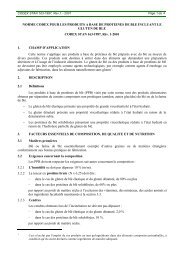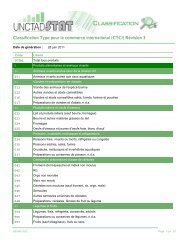issues and constraints related to the development of cashew nuts ...
issues and constraints related to the development of cashew nuts ...
issues and constraints related to the development of cashew nuts ...
You also want an ePaper? Increase the reach of your titles
YUMPU automatically turns print PDFs into web optimized ePapers that Google loves.
12Obvious <strong>cashew</strong> growth deficiencies are not a major problem (unless linked <strong>to</strong> drying <strong>of</strong> flowers)<strong>and</strong> although <strong>the</strong>re is work <strong>to</strong> be done in this area, it is not a high priority.Bush fires <strong>and</strong> <strong>the</strong> subsequent damage <strong>to</strong> <strong>cashew</strong> is one <strong>of</strong> <strong>the</strong> major <strong>constraints</strong> <strong>to</strong> <strong>cashew</strong>production at <strong>the</strong> moment. A comprehensive review <strong>of</strong> <strong>the</strong> literature needs <strong>to</strong> be undertaken <strong>to</strong>see what approaches have been adopted in o<strong>the</strong>r parts <strong>of</strong> <strong>the</strong> world, <strong>and</strong> for o<strong>the</strong>r crops, <strong>to</strong>determine how this can be applied <strong>to</strong> <strong>cashew</strong>, a crop that fruits <strong>to</strong>wards <strong>the</strong> end <strong>of</strong> <strong>the</strong> dry seasonwhen fires are at <strong>the</strong>ir most devastating.Cashew has a very valuable role <strong>to</strong> play in bush fire reduction in general, because it yields in <strong>the</strong>dry season. Experience in o<strong>the</strong>r countries has shown that as a ‘<strong>cashew</strong> culture’ develops, withmore <strong>and</strong> more farmers growing <strong>cashew</strong>, fires are almost au<strong>to</strong>matically brought under control.A closer look at <strong>the</strong> economics <strong>of</strong> high density planting is required <strong>and</strong> should be undertaken inall <strong>the</strong> countries, since yield potentials <strong>and</strong> input costs (such as labour for weeding), will varyconsiderably.2.3 Constraints <strong>related</strong> <strong>to</strong> breeding, planting material <strong>and</strong> researchThe previous section gave a realistic picture <strong>of</strong> <strong>the</strong> major biotic <strong>and</strong> environmental <strong>constraints</strong> <strong>to</strong><strong>cashew</strong> production in <strong>the</strong> region, on which breeders can start selecting resistant or <strong>to</strong>lerant types,in addition <strong>to</strong> <strong>the</strong> normal characteristics <strong>of</strong> good yield <strong>and</strong> quality.There follows a brief review <strong>of</strong> existing germplasm <strong>and</strong> what breeding work has been carried outin individual countries. GuineaThe “original” germplasm collection at CRAF (Centre de Recherche Agronomique de Foulaya)was a group <strong>of</strong> sixty-one old trees, planted as seed in <strong>the</strong> 1950s. Although originally planted at agood spacing, <strong>the</strong> trees are now somewhat over-crowded. The source <strong>of</strong> <strong>the</strong>se trees is unknown,although Tanzania <strong>and</strong> Mozambique have been suggested as possibilities. The reason for <strong>the</strong>irselection is also unknown; at <strong>the</strong> time <strong>of</strong> planting <strong>the</strong>ir purpose might have been for forestry, orjust <strong>to</strong> have <strong>cashew</strong> on <strong>the</strong> research station for student studies. Characterisation <strong>of</strong> <strong>nuts</strong> from<strong>the</strong>se trees has started.A second germplasm collection at Kankan consisted <strong>of</strong> seed from some <strong>of</strong> <strong>the</strong> original Foulayacollection <strong>and</strong> seed from a few selected trees in <strong>the</strong> region. These trees were planted veryrecently, in 1998 <strong>and</strong> 1999. There were no replicates <strong>and</strong> <strong>the</strong> researchers did not know how manytrees were surviving (although this appeared <strong>to</strong> be low).The only new plant material <strong>of</strong> known provenance recently introduced in<strong>to</strong> Guinea was seed fromBrazilian clones CCP 09, CCP 1001 <strong>and</strong> CCP 076. Unfortunately, only small percentages havegerminated. These seeds were imported without any quarantine procedures. This is potentiallyvery dangerous, as Brazil has <strong>cashew</strong> pests <strong>and</strong> diseases that are not found in West Africa.Before importing more <strong>cashew</strong> seeds from o<strong>the</strong>r countries, especially outside <strong>of</strong> West Africa,suitable quarantine procedures must be put in<strong>to</strong> place.A new germplasm trial at Boke has been planted from seed, <strong>and</strong> so all <strong>the</strong> new plants were halfsiblings<strong>and</strong> not clones <strong>of</strong> <strong>the</strong> original mo<strong>the</strong>r trees. New material included seed from:• <strong>the</strong> best trees in <strong>the</strong> “original” collection,


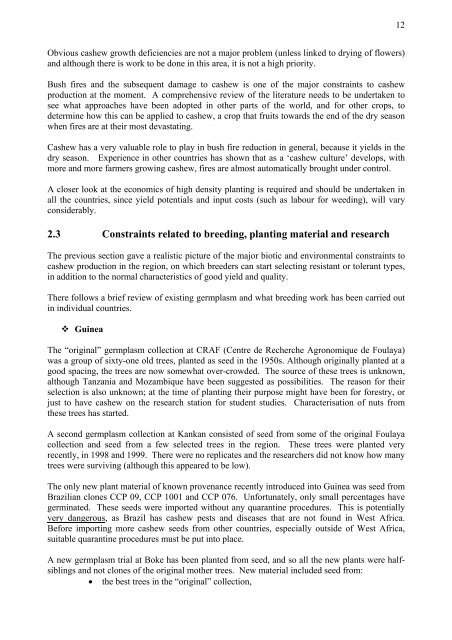
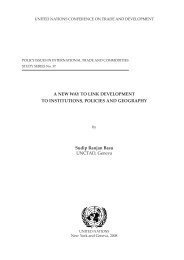

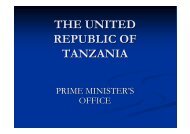
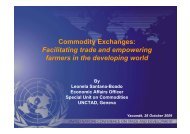
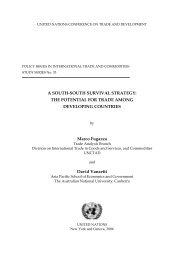
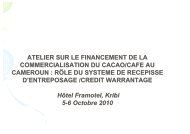
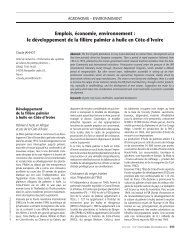
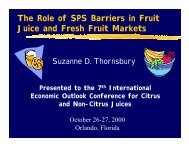

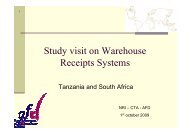
![Warehouse Receipt Systems: Legal Issues [PDF]](https://img.yumpu.com/43979338/1/190x134/warehouse-receipt-systems-legal-issues-pdf.jpg?quality=85)
